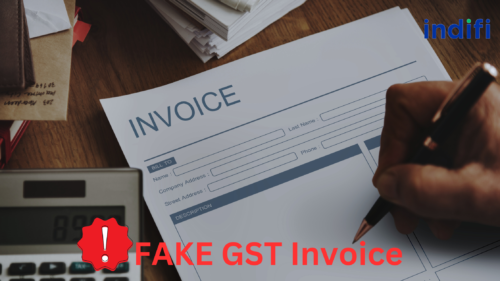
The GST has brought about a lot of significant changes in the taxation system and has simplified the process of the indirect system. It is good that there is a sharp increase in GST registration
However, the GST fake invoice case is also on the rise. Fake GST bills can lead to tax evasion, loss of tax revenue to the government, and other fraudulent practices. It is crucial to check the authenticity of the GST invoice to avoid getting cheated. How to check if a GST bill is fake or genuine? Here is a detailed easy-to-understand guide to help you.
Also Read:- Everything You Need to Know About Jurisdiction of GST State Code List
What is a Fake GST Bill?
First, you have to know what is a fake invoice GST. Any bill generated without any transaction is a Fake GST bill. It is created for money laundering, GST evasion, fake purchases, etc. It is illegal and punishable. Hence, you have to follow a few steps to identify a fake invoice.
How to Identify a Fake GST Bill?
1 Know The Basics of A GST Bill
You should first know about the basic elements of a GST invoice if you want to check its authenticity.
It consists of details including the name of the supplier, name of the receiver, GSTIN, invoice number, date of the invoice, HSN code, rate of the applicable tax, quantity, and value.
Unless you are familiar with the elements, you will not be able to find the discrepancies.
2 Verify the GSTIN
The first step is to validate the GSTIN or Goods and Services Tax Identification Number. It is the 15-digit alphanumeric code allotted to all registered taxpayers. It is of great help to identify all genuine GST transactions. How to verify it?
Visit the official GST portal or GST mobile app.
- Click on ‘Search Taxpayer’.
- Then click on ‘Search by GSTIN’.
- Enter the GSTIN from the invoice.
- Click on the ‘submit’ button after filling out the captcha.
- You can see all the details like the name of the business, address, and status of registration.
- Check and confirm if the details on the invoice match the details on the portal.
3 Invoice Number and Date
Check if the invoice number follows a logical sequence. If no logical sequence is followed, it could indicate that the invoice is fake. Moreover, you should check if the invoice date aligns with the supplier’s transaction date.
4 Details of Supplier and Receiver
Verify if the details of the supplier and receiver, such as the legal name, address, and GSTIN, are accurate. Cross-check the details with the information available on the portal.
5 Tax and Invoice Amount
When you visit the GST portal you will be able to see a GST calculator. Use it to calculate the tax amount. Check if the invoice has the same tax amount. Any significant deviations can be a red flag that the GST bill is fake.
Also Read:- How To Download GST Certificate Online By PAN & ARN No.
6 HSN codes
HSN code refers to the Harmonized System of Nomenclature that is accepted worldwide. It is a 6-digit code that classifies thousands of products. Check if the HSN code in the invoice is relevant to the product or service. A misrepresentation will show that the invoice is not genuine.
7 GST Rate Finder
Some sellers may charge the wrong rate of GST. In this type of GST fake invoice case, you can verify the GST rate by checking the GST rate chart on the portal.
Also Read:- GST Express Software – Key Features & Benefits For MSMEs
8 Scan the QR code
GSTs come with a QR or Quick Response code. It makes it easier to check GST bills as it contains all the important details about the invoice. Moreover, it adds an extra layer of security to the invoice.
| Check the e-way bill number If your invoice includes an e-way bill number, you should check the legitimacy of the transportation of goods. |
| Visit the e-way bill portal Enter the e-way bill number and verify it. |
| Check the signature GST bills should be signed by the supplier or the person authorized by him. Make sure the signature of the supplier matches the specimen signature or Digital Signatures. |
9 Use Third-Party Tools
Apart from the official government resources, several third-party tools and experts are available to verify if a GST invoice is authentic or not.
They use advanced techniques and algorithms to detect altered and fake invoices. Moreover, you can get help from financial experts and tax consultants to guide you to find counterfeit GST invoices.
Verifying the genuineness of GST invoice number checks is vital for consumers and businesses. This helps to avoid legal consequences and financial risks. By following the guidelines mentioned above, you can easily identify fake GST bills.
How to Report Fake GST Invoices: A Step-by-Step Guide
If you come across cases of fake GST invoices, follow these steps to report them:
Official GST Portal: Visit the official GST portal and register your complaint using the ‘CBEC Mitra Helpdesk’ and ‘Raise Web Ticket’ options.
Also Read:- How GST E Invoice Prevent Frauds in Business Transactions?
Email Complaint: Send a detailed email outlining the issue to cbecmitra.helpdesk@icegate.gov.in.
Social Media Outreach: Reach out to the concerned authority by tagging GST’s official Twitter handle and providing relevant information about the fake GST invoices.
Remember to include all necessary details and evidence in your complaint for a more effective response. Stay vigilant in combating fraudulent activities related to GST.
Do you suspect the invoice to be fake after checking and verifying it? Do you have enough evidence to support your suspicion? If so, it is important to report it to the relevant authorities. You can register your complaint in the GST Helpline or you can notify the tax authorities and provide them all your supporting evidence. This will not only help to prevent fraudulent GST practices but also maintain the integrity of the taxation system.
FAQs
How to check GST bill is real or fake?
If you think a GST bill might not be right, here’s what you can do to check it:
- Visit gst.gov.in.
- Look for and click on the ‘Search Taxpayer’ section on the main page.
- Type in the GSTIN (GST Identification Number) of the supplier from the bill into the search box.
- Click the search button. If the bill is okay, you’ll see all the supplier’s details on the screen.
How to check the original GST bill?
To check if a GST bill is original, ensure it has:
- The supplier’s GSTIN (GST Identification Number).
- The buyer’s details, including GSTIN if applicable.
- A unique invoice number.
- The date of issue.
- Description of goods/services with HSN/SAC codes.
- The GST rates and amount.
- Total value and tax breakup.
How to verify the invoice number?
To verify an invoice number:
- Check the Format: Ensure the invoice number follows the standard or expected format used by the issuing company (e.g., alphanumeric, length, sequence).
- Cross-Reference Records: Compare the invoice number with internal records, such as previous invoices or accounting software, to see if it matches the sequence and hasn’t been duplicated.
- Verify with Vendor/Client: If in doubt, contact the issuing party (vendor or client) to confirm the invoice number and details.
- Check for Consistency: Ensure the invoice number is consistent with other information on the invoice, like the date and purchase order number.
How to check GST Bill online?
To check a GST (Goods and Services Tax) bill online in India, you can use the GST Portal or the GST app. Here’s how you can do it:
Check GST Bill on the GST Portal:
- Step 1: Visit the official GST Portal at https://www.gst.gov.in.
- Step 2: Log in to your account using your credentials (username and password).
- Step 3: Once logged in, navigate to the ‘Services’ tab.
- Step 4: Under the ‘Returns’ section, select ‘Track Return Status.’
- Step 5: Enter the ARN (Application Reference Number) of the bill or invoice you want to check.
- Step 6: Click on ‘Search.’ The details of the GST bill will be displayed.
Where can I complain about a fake GST bill?
You can visit the official GST portal and register your complaint through the CBEC Mitra Helpdesk or by using the Raise Web Ticket option. Alternatively, you can send an email with your query or issue to cbicmitra.helpdesk@icegate.gov.in.

